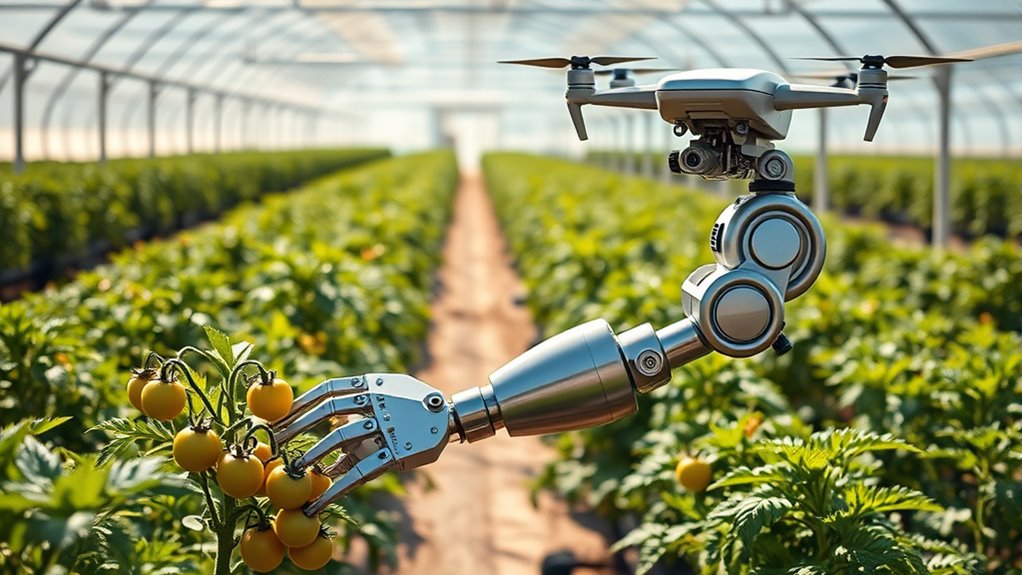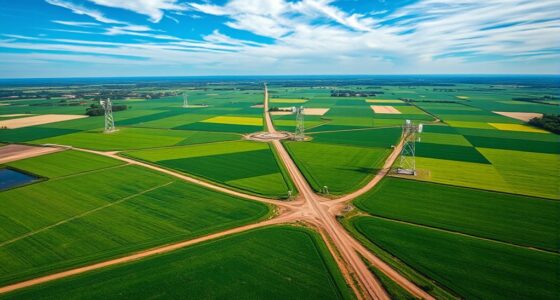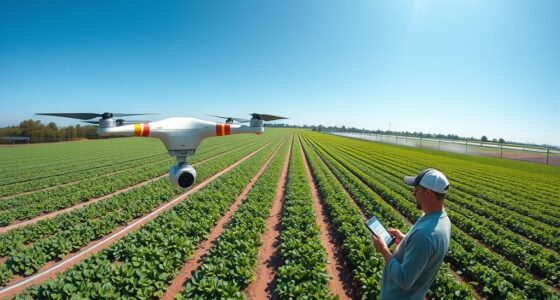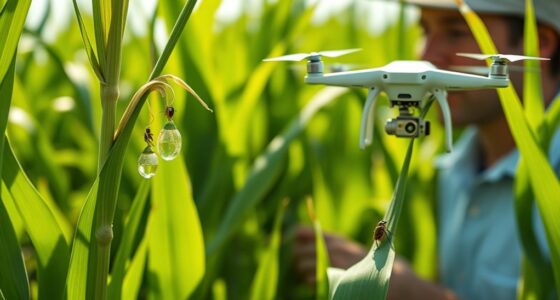Robotics and automation are revolutionizing your agricultural operations by boosting efficiency, lowering labor costs, and enabling precise resource management. With sensors, drones, and autonomous machinery, you can detect diseases early, analyze soil health instantly, and automate routine tasks like planting and harvesting. This technology also helps optimize water and fertilizer use, saving costs and protecting the environment. Explore further to discover how these innovations can transform your farm into a smarter, more sustainable enterprise.
Key Takeaways
- Robots equipped with sensors and cameras enable early disease detection and targeted treatment, improving crop health.
- Automated systems collect soil data for precise resource management, promoting sustainable farming practices.
- Autonomous machinery handle planting, watering, and harvesting tasks, increasing efficiency and reducing labor costs.
- Integrated data from sensors, soil analysis, and weather stations support smarter decision-making and operational optimization.
- Robotic automation conserves water and energy, lowers costs, and minimizes environmental impact in agricultural operations.
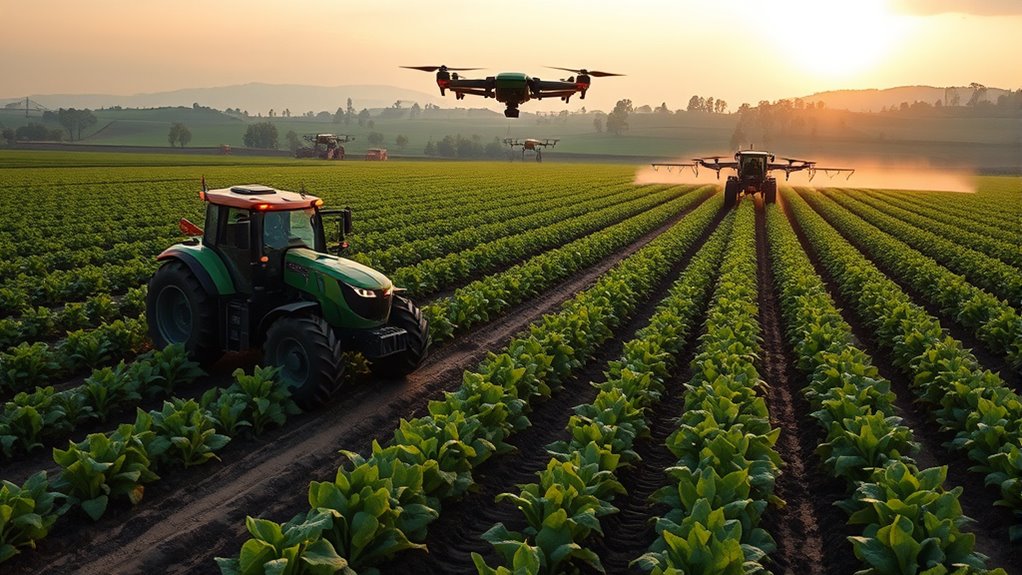
Have you ever wondered how robotics and automation are transforming modern farming? These advanced technologies are revolutionizing the way you manage your fields, making farming more efficient, precise, and sustainable. With the help of robots and automated systems, you can now monitor crops more closely, detect issues early, and optimize resource use—all while reducing labor costs and increasing yields. One of the most significant breakthroughs is in disease detection. By deploying robotic systems equipped with sensors and cameras, you can identify signs of disease at an early stage, often before symptoms are visible to the naked eye. These robots analyze plant health in real-time, scanning for color changes, leaf spots, or other indicators of infection. This rapid detection allows you to act swiftly, applying targeted treatments only where needed, which minimizes chemical use and curtails the spread of disease across your farm.
Robotics enable early disease detection, minimizing chemical use and protecting your crops efficiently.
Soil analysis is another area where automation makes a remarkable impact. Traditional soil testing can be time-consuming and often involves sending samples to labs, which delays decision-making. Automated soil analysis systems, on the other hand, gather data directly from your fields using ground-based robots or drone-mounted sensors. These devices measure soil moisture, nutrient levels, pH, and other critical factors, providing you with detailed insights instantly. With this information, you can make informed decisions about fertilization, irrigation, and crop selection, ensuring your plants receive exactly what they need to thrive. This precision helps increase productivity while conserving water and reducing the use of fertilizers and pesticides, aligning with sustainable farming practices.
Robotics also streamline routine tasks like planting, watering, and harvesting, freeing you from physically demanding work and reducing human error. Autonomous machinery can work around the clock, ensuring that your crops are consistently cared for without interruptions. For example, robotic harvesters can identify ripe produce, pick it carefully, and transport it to collection points efficiently, minimizing waste and damage. Automated systems also enhance data collection, integrating information from disease detection sensors, soil analysis devices, and weather stations into comprehensive farm management platforms. This integration allows you to make smarter, data-driven decisions that optimize your entire operation.
In addition, robotic automation can help you better manage resources like water and energy, leading to cost savings and environmental benefits. In essence, robotics and automation are providing you with tools to farm smarter, not harder. They enable early disease detection, precise soil analysis, and efficient task management, all of which contribute to higher yields, healthier crops, and a more sustainable future. As these technologies continue to advance, you’ll find yourself better equipped to meet the challenges of modern agriculture with confidence and precision.
Frequently Asked Questions
What Are the Cost Implications for Small-Scale Farmers Adopting Automation?
Adopting automation may require a significant initial investment, but it can lead to long-term cost savings through increased efficiency and reduced labor needs. You might find that automation tools help you save on operational costs over time, making the investment worthwhile. While the upfront costs can be high, the potential for improved productivity and lower expenses can make automation a smart choice for small-scale farmers like you.
How Do Robotics Handle Unpredictable Weather Conditions and Crop Variability?
Robotics are like vigilant sentinels, tirelessly adjusting to nature’s unpredictable moods. They utilize advanced sensors and AI to navigate weather adaptability and crop variability management, making real-time decisions amid stormy skies or sudden droughts. Their flexible algorithms learn from each season’s quirks, ensuring crops get the right care. With this adaptability, you gain resilience against weather’s whims, safeguarding your harvest and smoothing out the unpredictability of nature’s rollercoaster.
What Safety Measures Are in Place for Workers Operating Robotic Equipment?
You should follow strict safety protocols when operating robotic equipment, including regular sensor calibration to make certain of accurate functioning. Always stay aware of emergency protocols, such as shutdown procedures and emergency stop buttons, to protect yourself if something goes wrong. Wear appropriate safety gear and stay trained on equipment updates. These measures help prevent accidents and ensure safe operation, keeping you protected while working alongside automated systems.
How Is Data Privacy Managed in Automated Agricultural Systems?
Data privacy in automated agricultural systems is a fortress protecting your valuable information. You rely on robust data encryption to keep sensitive data safe from cyber threats. Access control ensures only authorized personnel can view or modify the data, preventing breaches. Regular security audits and secure passwords further strengthen this shield. By implementing these measures, you can confidently operate your systems, knowing your data is safeguarded against any digital invasion.
What Training Is Needed for Farmers to Operate Advanced Robotic Machinery?
You’ll need training in robotics maintenance and machinery calibration to operate advanced robotic machinery effectively. This includes understanding how to troubleshoot mechanical and software issues, perform routine upkeep, and fine-tune equipment for *the best* performance. Hands-on sessions or workshops are essential, so you become comfortable with controlling and adjusting robotic systems. Staying updated on new features and safety protocols ensures you operate machinery confidently and maintain productivity on your farm.
Conclusion
As you embrace robotics and automation in agriculture, you’re opening the door to a future where technology acts as your loyal partner, turning complex tasks into a well-orchestrated symphony. These innovations are like a gust of fresh air, making farming more efficient, sustainable, and less labor-intensive. By harnessing this technology, you’re not just growing crops—you’re cultivating a smarter, more resilient agricultural landscape that blooms with endless possibilities.
